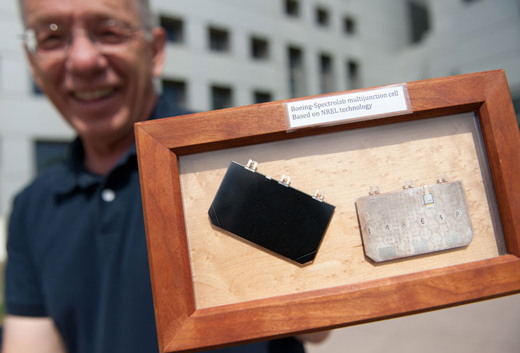- News
21 June 2011
NREL’s Jerry Olson wins IEEE's Cherry Award
At the 37th IEEE Photovoltaic Specialist Conference (PVSC37) in Seattle, WA, USA this week (19–24 June), Jerry Olson, a principal scientist in the III-V Materials and Devices Group at the US Department of Energy’s National Renewable Energy Laboratory (NREL) in Golden, CO, USA, has received the Cherry Award from the Institute of Electrical and Electronics Engineers (IEEE).

The award is named in honor of William R. Cherry, a founder of the photovoltaic community. In the 1950s, he was instrumental in establishing solar cells as the ideal power source for space satellites and for recognizing, advocating and nurturing the use of photovoltaic systems for terrestrial applications. The award was instituted in 1980, shortly after his death. Its purpose is to recognize individual engineers or scientists who devoted a part of their professional life to the advancement of the science and technology of photovoltaic energy conversion. It is only awarded to scientists who are still actively contributing to the field.
IEEE says that Olson opened the door for multi-junction solar cells by showing that a top cell of gallium indium phosphide (GaInP) and a bottom cell of gallium arsenide (GaAs) can capture and convert photons more efficiently into electricity than previous attempts at using other materials.
He and his co-workers showed that the multi-junction concentrator cells not only use a fraction of the electronic materials used by the thicker flat-plate cells, but they can capture more light through the course of a day.
Olson’s 1984 breakthrough was embraced by NASA, which uses multi-junction solar cells based on his invention to power most space satellites, as well as the Mars rovers, Spirit and Opportunity.
Most groups working in multi-junction solar cells at the time were looking for a combination of bandgap energies that would yield maximum theoretical efficiency, with less emphasis on the chemical and structural compatibility of the different semiconductor layers. In essence they were “trying too hard to hit the bull’s eye,” according to Olson.
The key was to find materials that were compatible (and more likely to be manufactured) but that still had a bandgap combination that would deliver high theoretical efficiency. That combination was a top cell of GaInP with a bandgap of 1.9eV and a bottom cell of GaAs with a bandgap of 1.4eV. These two compound semiconductors are chemically compatible and have the same lattice constant.
Today’s PV concentrators, which can extract 30–40W from a small 1cm2 solar cell by using lenses to focus the power of 1000 suns on the cell, are a direct descendant of Olson’s multi-junction breakthrough, says NREL.
Sarah Kurtz, acting director of the National Center for Photovoltaics at NREL, joined the lab a couple years after Olson’s invention. The pair has been instrumental in clearing hurdles to ensure that the GaInP/GaAs solar cell remains the top cell for efficiency.
“Jerry wasn’t dissuaded by things in the literature that might give erroneous directions,” says Kurtz. “He was willing to set that aside even in the face of people telling him that his approach would never work,” she adds.
Jerry Olson Multi-junction solar cells GaInP GaAs
